Thermal Infrared Imaging from Drones Offers a Major Advance for Spider Monkey Surveys
Abstract
:1. Introduction
2. Materials and Methods
2.1. Study Area and Subjects
2.2. Mission Planning
2.3. Data Collection
2.4. Data Analysis
2.4.1. Presence of Spider Monkeys in TIR Drone Data
2.4.2. Counting Spider Monkeys
3. Results
3.1. Presence of Spider Monkeys
3.2. Counting Spider Monkeys
3.3. Observations on the Reactions of Spider Monkeys to the Drone
4. Discussion
5. Conclusions
Supplementary Materials
Author Contributions
Funding
Acknowledgments
Conflicts of Interest
Appendix A
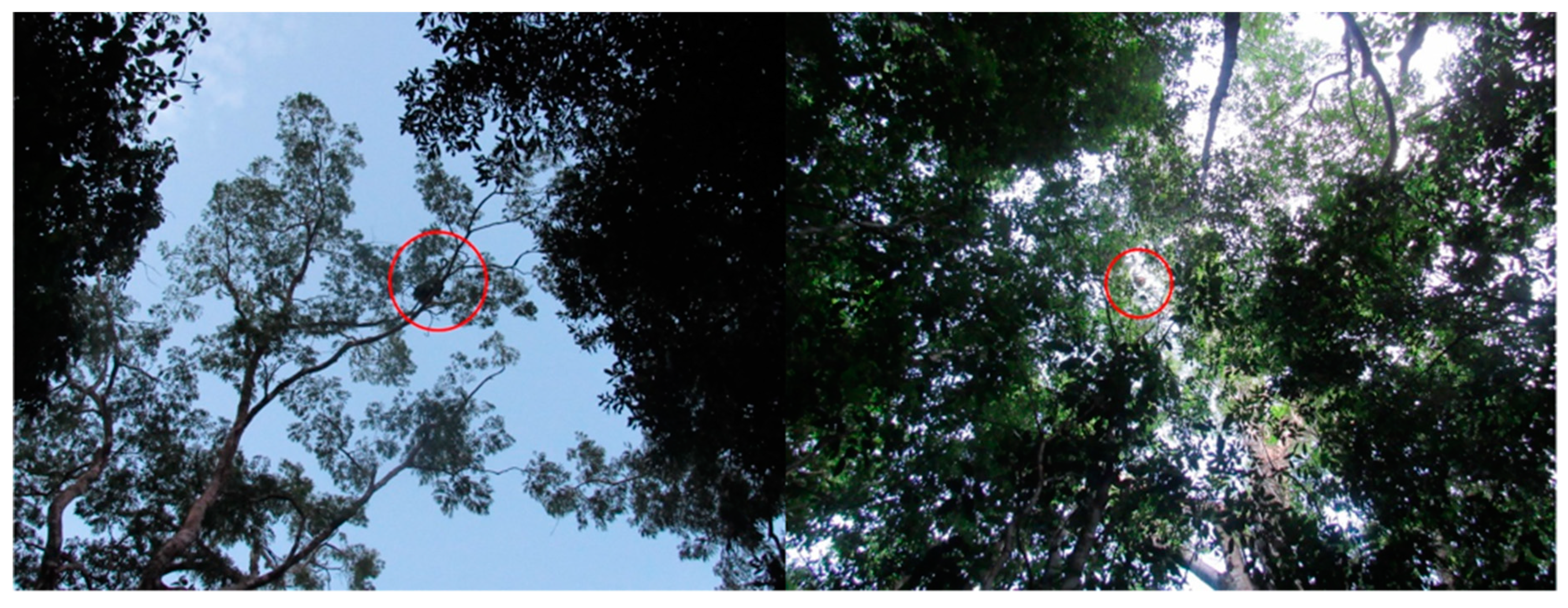
Appendix B

Appendix C
| Sleeping Site | Date Flight | Start Flight | Time of Day | Type of Flight | Height of Drone AGL | Monkey Subgroup Type * | Individuals Counted on the Ground | Individuals Counted from TIR Footage | Additional Individuals Counted from TIR Footage |
|---|---|---|---|---|---|---|---|---|---|
| A | 10/6/2018 | 19:00 | PM | Grid | 70 | S | 9 | 9 | 7 |
| 11/6/2018 | 5:45 | AM | Grid | 70 | S | 9 | 9 | 12 | |
| 11/6/2018 | 6:00 | AM | Grid | 50 | S | 7 | 6 | 8 | |
| 18/6/2018 | 19:30 | PM | Grid | 70 | S | 9 | 9 | 0 | |
| 20/6/2018 | 19:15 | PM | Grid | 80 | L | 11 | 8 | 4 | |
| 20/6/2018 | 19:30 | PM | Hover | 70-60 | L | 12 | 13 | 0 | |
| 22/6/2018 | 19:30 | PM | Grid | 70 | L | 11 | 11 | 0 | |
| 23/6/2018 | 5:45 | AM | Grid | 70 | S | 9 | 7 | 5 | |
| B | 11/6/2018 | 18:45 | PM | Grid | 70 | S1 | 1 | 3 | 9 |
| S2 | 3 | 0 | |||||||
| 11/6/2018 | 19:15 | PM | Grid | 70 | S1 | 4 | 4 | 1 | |
| L2 | 6 | 10 | |||||||
| 12/6/2018 | 5:45 | AM | Grid | 70 | S | 3 | 3 | 10 | |
| 18/6/2018 | 5:45 | AM | Grid | 70 | S | 3 | 2 | 2 | |
| 18/6/2018 | 6:00 | AM | Grid | 70 | S | 0 | 2 | 0 | |
| 18/6/2018 | 18:45 | PM | Grid | 70 | S | 8 | 9 | 7 | |
| 18/6/2018 | 19:00 | PM | Grid | 70 | L | 10 | 7 | 6 | |
| 19/6/2018 | 5:45 | AM | Grid | 70 | S1 | 1 | 1 | 6 | |
| L2 | 8 | 10 | |||||||
| 19/6/2018 | 18:45 | PM | Hover | 70-60 | L | 10 | 16 | 0 | |
| 19/6/2018 | 19:00 | PM | Grid | 70 | L | 6 | 11 | 2 | |
| 19/6/2018 | 19:30 | PM | Grid | 70 | L | 7 | 10 | 6 | |
| 20/6/2018 | 5:45 | AM | Grid | 70 | L1 | 6 | 15 | 3 | |
| S2 | 3 | 1 | |||||||
| S3 | 3 | 0 | |||||||
| 20/6/2018 | 18:45 | PM | Hover | 70-60 | L | 5 | 10 | 0 | |
| 22/6/2018 | 18:45 | PM | Grid | 70 | S1 | 7 | 9 | 0 | |
| S2 | 2 | 2 | |||||||
| 22/6/2018 | 19:00 | PM | Hover | 70-60 | L1 | 5 | 11 | 0 | |
| S2 | 3 | 4 | |||||||
| C | 14/6/2018 | 5:45 | AM | Grid | 70 | S | 2 | 2 | 0 |
| 14/6/2018 | 6:00 | AM | Grid | 60 | S | 2 | 2 | 0 | |
| 21/6/2018 | 5:45 | AM | Grid | 70 | S | 6 | 5 | 0 | |
| 22/6/2018 | 5:45 | AM | Grid | 70 | S | 5 | 4 | 0 | |
| 22/6/2018 | 6:00 | AM | Grid | 70 | S | 0 | 0 | 0 |
Appendix D
Appendix E
| Sleeping Site | Individuals Counted on the Ground | Individuals Counted on Drone TIR Footage | ||||
|---|---|---|---|---|---|---|
| PM | AM | Difference | PM | AM | Difference | |
| A | 9 | 9 | 0 | 9 | 9 | 0 |
| A | 11 | 9 | 2 | 11 | 7 | 4 |
| B | 3 | 3 | 0 | 0 | 3 | −3 |
| B | 10 | 8 | 2 | 7 | 10 | −3 |
| B | 7 | 6 | 1 | 10 | 15 | −5 |
References
- Gibbs, H.K.; Ruesch, A.S.; Achard, F.; Clayton, M.K.; Holmgren, P.; Ramankutty, N.; Foley, J.A. Tropical forests were the primary sources of new agricultural land in the 1980s and 1990s. Proc. Natl. Acad. Sci. 2010, 107, 16732–16737. [Google Scholar] [CrossRef] [PubMed] [Green Version]
- Hansen, M.C.; Potapov, P.V.; Moore, R.; Hancher, M.; Turubanova, S.A.; Tyukavina, A.; Thau, D.; Stehman, S.V.; Goetz, S.J.; Loveland, T.R.; et al. High-resolution global maps of 21st-century forest cover change. Science 2013, 342, 850–853. [Google Scholar] [CrossRef] [PubMed]
- Graesser, J.; Aide, T.M.; Grau, H.R.; Ramankutty, N. Cropland/pastureland dynamics and the slowdown of deforestation in Latin America. Environ. Res. Lett. 2015, 10, 034017. [Google Scholar] [CrossRef] [Green Version]
- Campbell, G.; Head, J.; Junker, J.; Nekaris, K.A.I. Primate abundance and distribution: Background concepts and methods. In An Introduction to Primate Conservation; Wich, S.A., Marshall, A.J., Eds.; Oxford University Press: Oxford, UK, 2016; pp. 79–104. [Google Scholar]
- Munari, D.P.; Keller, C.; Venticinque, E.M. An evaluation of field techniques for monitoring terrestrial mammal populations in Amazonia. Mamm. Biol. 2011, 76, 401–408. [Google Scholar] [CrossRef]
- Neilson, E.; Nijman, V.; Nekaris, K.A.I. Conservation assessments of arboreal mammals in difficult terrain: Occupancy modeling of Pileated Gibbons (Hylobates pileatus). Int. J. Primatol. 2013, 34, 823–835. [Google Scholar] [CrossRef]
- Di Fiore, A.; Link, A.; Campbell, C.J. The atelines: Behavioural and socioecological diversity in a New World monkey radiation. In Primates in Perspective; Campbell, C.J., Fuentes, A., MacKinnon, K.C., Bearder, S.K., Stumpf, R.M., Eds.; Oxford University Press: New York, NY, USA, 2011; pp. 155–188. [Google Scholar]
- Cuarón, A.D.; Morales, A.; Shedden, A.; Rodriguez-Luna, E.; de Grammont, P.C.; Cortés-Ortiz, L. Ateles geoffroyi. In The IUCN Rest List of Threatened Species; IUCN: Cambridge, UK, 2008. [Google Scholar]
- Michalski, F.; Peres, C.A. Anthropogenic determinants of primate and carnivore local extinctions in a fragmented forest landscape of southern Amazonia. Biol. Conserv. 2005, 124, 383–396. [Google Scholar] [CrossRef]
- Weghorst, J.A. High population density of black-handed spider monkeys (Ateles geoffroyi) in Costa Rican lowland wet forest. Primates 2007, 48, 108–116. [Google Scholar] [CrossRef]
- Aquino, R.; Cornejo, F.M.; Pezo, E.; Heymann, E.W. Distribution and abundance of white-fronted spider monkeys, Ateles belzebuth (Atelidae), and threats to their survival in Peruvian Amazonia. Folia Primatol. 2012, 84, 1–10. [Google Scholar] [CrossRef]
- Marshall, A.R.; Lovett, J.O.N.C.; White, P.C.L. Selection of line-transect methods for estimating the density of group-living animals: Lessons from the primates. Am. J. Primatol. 2008, 462, 452–462. [Google Scholar] [CrossRef] [PubMed]
- Buckland, S.T.; Plumptre, A.J.; Thomas, L.; Rexstad, E.A. Design and analysis of line transect surveys for primates. Int. J. Primatol. 2010, 31, 833–847. [Google Scholar] [CrossRef]
- Ramos-Fernández, G.; Wallace, R.B. Spider monkey conservation in the twenty-first century: Recognizing risks and opportunities. In Spider Monkeys Behaviour, Ecology and Evolution of The Genus Ateles; Campbell, C.J., Ed.; Cambridge University Press: Cambridge, UK, 2008; pp. 351–376. [Google Scholar]
- Aureli, F.; Schaffner, C.M.; Boesch, C.; Simon, K.; Call, J.; Chapman, C.A.; Connor, R.; Di, A.; Dunbar, R.I.M.; Henzi, S.P.; et al. Fission-fusion dynamics new research frameworks. Curr. Anthropol. 2008, 49, 627–654. [Google Scholar] [CrossRef]
- Fedigan, L.M.; Jack, K. Neotropical primates in a regenerating Costa Rican dry forest: A comparison of howler and capuchin population Patterns. Int. J. Primatol. 2001, 22, 689–713. [Google Scholar] [CrossRef]
- Wich, S.A.; Koh, L.P. Conservation Drones. Mapping and Monitoring Biodiversity; Oxford University Press: Oxford, UK, 2018. [Google Scholar]
- Longmore, S.N.; Collins, R.P.; Pfeifer, S.; Fox, S.E.; Mulero-Pázmány, M.; Bezombes, F.; Goodwin, A.; De Juan Ovelar, M.; Knapen, J.H.; Wich, S.A. Adapting astronomical source detection software to help detect animals in thermal images obtained by unmanned aerial systems. Int. J. Remote Sens. 2017, 38, 2623–2638. [Google Scholar] [CrossRef] [Green Version]
- Mulero-Pázmány, M.; Stolper, R.; van Essen, L.D.; Negro, J.J.; Sassen, T. Remotely piloted aircraft systems as a rhinoceros anti-poaching tool in Africa. PLoS One 2014, 9, e83873. [Google Scholar] [CrossRef] [PubMed]
- Chrétien, L.-P.; Théau, J.; Ménard, P. Visible and thermal infrared remote sensing for the detection of white-tailed deer using an unmanned aerial system. Wildl. Soc. Bull. 2016, 40, 181–191. [Google Scholar] [CrossRef]
- Gonzalez, L.; Montes, G.; Puig, E.; Johnson, S.; Mengersen, K.; Gaston, K.; Gonzalez, L.F.; Montes, G.A.; Puig, E.; Johnson, S.; et al. Unmanned Aerial Vehicles (UAVs) and artificial intelligence revolutionizing wildlife monitoring and conservation. Sensors 2016, 16, 97. [Google Scholar] [CrossRef] [PubMed]
- Seymour, A.C.; Dale, J.; Hammill, M.; Halpin, P.N.; Johnston, D.W. Automated detection and enumeration of marine wildlife using unmanned aircraft systems (UAS) and thermal imagery. Sci. Rep. 2017, 7, 45127. [Google Scholar] [CrossRef] [PubMed] [Green Version]
- Kays, R.; Sheppard, J.; Mclean, K.; Welch, C.; Paunescu, C.; Wang, V.; Kravit, G.; Crofoot, M. Hot monkey, cold reality: Surveying rainforest canopy mammals using drone-mounted thermal infrared sensors. Int. J. Remote Sens. 2019, 40, 407–419. [Google Scholar] [CrossRef]
- Van Andel, A.C.; Wich, S.A.; Boesch, C.; Koh, L.P.; Robbins, M.M.; Kelly, J.; Kuehl, H.S. Locating chimpanzee nests and identifying fruiting trees with an unmanned aerial vehicle. Am. J. Primatol. 2015, 77, 1122–1134. [Google Scholar] [CrossRef]
- Bonnin, N.; Van Andel, A.; Kerby, J.; Piel, A.; Pintea, L.; Wich, S.; Bonnin, N.; Van Andel, A.C.; Kerby, J.T.; Piel, A.K.; et al. Assessment of chimpanzee nest detectability in drone-acquired images. Drones 2018, 2, 17. [Google Scholar] [CrossRef]
- Wich, S.; Dellatore, D.; Houghton, M.; Ardi, R.; Koh, L.P. A preliminary assessment of using conservation drones for Sumatran orang-utan (Pongo abelii) distribution and density. J. Unmanned Veh. Syst. 2016, 4, 45–52. [Google Scholar] [CrossRef]
- Defler, T.R.; Pintor, D. Censusing primates by transect in a forest of known primate density. Int. J. Primatol. 1985, 6, 243–259. [Google Scholar] [CrossRef]
- Pruetz, J.D.; Leasor, H.C. Survey of three primate species in forest fragments at La Suerte Biological Field Station, Costa Rica. Neotrop. Primates 2002, 10, 4–9. [Google Scholar]
- Chapman, C.A.; Schoof, V.A.M.; Bonnell, T.R.; Gogarten, J.F.; Calme, S. Competing pressures on populations: Long-term dynamics of food availability, food quality, disease, stress and animal abundance. Philos. Trans. R. Soc. B Biol. Sci. 2015, 370, 20140112. [Google Scholar] [CrossRef]
- Busia, L.; Smith-Aguilar, S.E.; Aureli, F.; Schaffner, C.M.; Ramos-Fernández, G. Predation attacks on wild spider monkeys (Ateles geoffroyi). Folia Primatol. 2018, 89, 341–346. [Google Scholar] [CrossRef]
- Cilulko, J.; Janiszewski, P.; Bogdaszewski, M.; Szczygielska, E. Infrared thermal imaging in studies of wild animals. Eur. J. Wildl. Res. 2013, 59, 17–23. [Google Scholar] [CrossRef]
- Burke, C.; Rashman, M.; Wich, S.; Symons, A.; Theron, C.; Longmore, S. Optimising observing strategies for monitoring animals using drone-mounted thermal infrared cameras. Int. J. Remote Sens. 2019, 40, 439–467. [Google Scholar] [CrossRef]
- Ramos-Fernández, G. Vocal communication in a fission-fusion society: Do spider monkeys stay in touch with close associates? Int. J. Primatol. 2005, 26, 1077–1092. [Google Scholar] [CrossRef]
- Croft, D.P.; James, R.; Krause, J. Exploring Animal Social Networks; Princeton University Press: Princeton, NJ, USA, 2008; ISBN 9781400837762. [Google Scholar]
- Watson, P.F.; Petrie, A. Method agreement analysis: A review of correct methodology. Theriogenology 2010, 73, 1167–1179. [Google Scholar] [CrossRef] [Green Version]
- Altman, D.G.; Bland, J.M. Measurement in medicine: The analysis of method comparison studies. Stat. 1983, 32, 307. [Google Scholar] [CrossRef]
- Chapman, C.A.; Struhsaker, T.T.; Skorupa, J.P.; Snaith, T.V.; Rothman, J.M. Understanding long-term primate community dynamics: Implications of forest change. Ecol. Appl. 2010, 20, 179–191. [Google Scholar] [CrossRef] [PubMed]
- Lin, L.I.-K. A concordance correlation coefficient to evaluate reproducibility. Biometrics 1989, 45, 255–268. [Google Scholar] [CrossRef] [PubMed]
- McBride, G.B. A Proposal for Strength-of-Agreement Criteria for Lin’s Concordance Correlation Coefficient; National Institute of Water and Atmospheric Research: Hamilton, New Zealand, 2005. [Google Scholar]
- Feng, D. agRee: Various Methods for Measuring Agreement, R Package Version 0.5-2; 2018. Available online: https://C RAN.R-project.org/package=agRee (accessed on 11 March 2019).
- R Core Team. R: A Language and Environment for Statistical Computing; R Core Team: Vienna, Austria, 2018. [Google Scholar]
- Burke, C.; Rashman, M.F.; Longmore, S.N.; McAree, O.; Glover-Kapfer, P.; Ancrenaz, M.; Wich, S.A. Successful observation of orangutans in the wild with thermal-equipped drones. J. Unmanned Veh. Syst. 2019, in press. [Google Scholar]
- Campbell, C.J.; Aureli, F.; Chapman, C.A.; Ramos-Fernández, G.; Matthews, K.; Russo, S.E.; Suarez, S.; Vick, L. Terrestrial behavior of Ateles spp. Int. J. Primatol. 2005, 26, 1039–1051. [Google Scholar] [CrossRef]
- Chapman, C.A.; Fedigan, L.M.; Fedigan, L. A comparison of transect methods of estimating population densities of Costa Rican primates. Brenesia 1988, 30, 67–80. [Google Scholar]
- Peres, C.A. General guidelines for standardizing line-transect surveys of tropical forest primates. Neotrop. Primates 1999, 7, 11–16. [Google Scholar]
- Stöcker, C.; Bennett, R.; Nex, F.; Gerke, M.; Zevenbergen, J.; Stöcker, C.; Bennett, R.; Nex, F.; Gerke, M.; Zevenbergen, J. Review of the current state of UAV regulations. Remote Sens. 2017, 9, 459. [Google Scholar] [CrossRef]
- Burke, C.; Rashman, M.F.; McAree, O.; Hambrecht, L.; Longmore, S.N.; Piel, A.K.; Wich, S.A. Addressing environmental and atmospheric challenges for capturing high-precision thermal infrared data in the field of astro-ecology. Proc. SPIE 2018. [Google Scholar] [CrossRef]
- Mulero-Pázmány, M.; Jenni-Eiermann, S.; Strebel, N.; Sattler, T.; Negro, J.J.; Tablado, Z. Unmanned aircraft systems as a new source of disturbance for wildlife: A systematic review. PLoS One 2017, 12, e0178448. [Google Scholar] [CrossRef]
- McAree, O.; Aitken, J.M.; Veres, S.M. Quantifying situation awareness for small unmanned aircraft. Aeronaut. J. 2018, 122, 733–746. [Google Scholar] [CrossRef]
- Witczuk, J.; Pagacz, S.; Zmarz, A.; Cypel, M. Exploring the feasibility of unmanned aerial vehicles and thermal imaging for ungulate surveys in forests—Preliminary results. Int. J. Remote Sens. 2018, 39, 5504–5521. [Google Scholar] [CrossRef]
- Ellis, E.A.; Romero Montero, J.A.; Hernández Gómez, I.U. Deforestation processes in the state of Quintana Roo, Mexico. Trop. Conserv. Sci. 2017, 10, 194008291769725. [Google Scholar] [CrossRef]


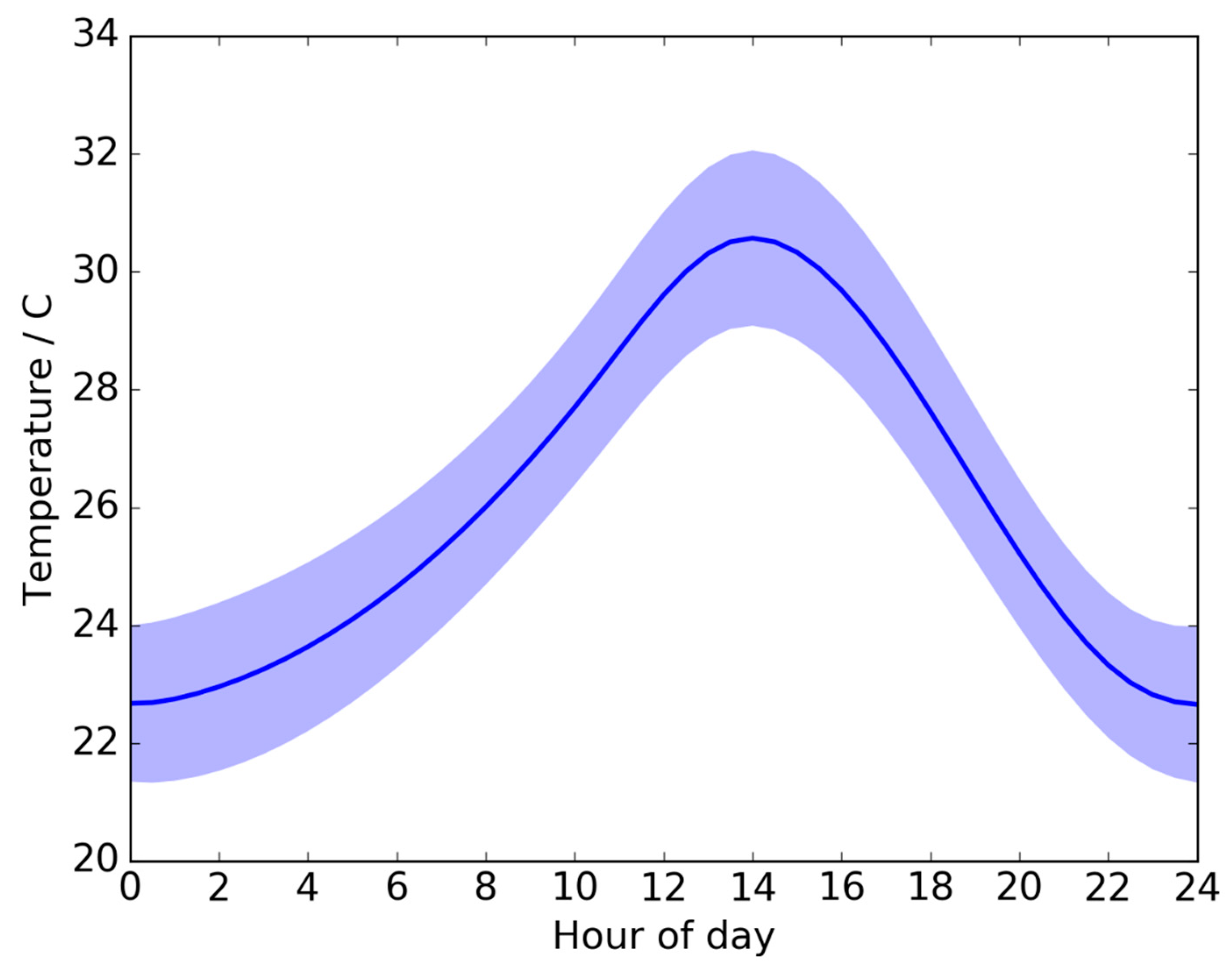
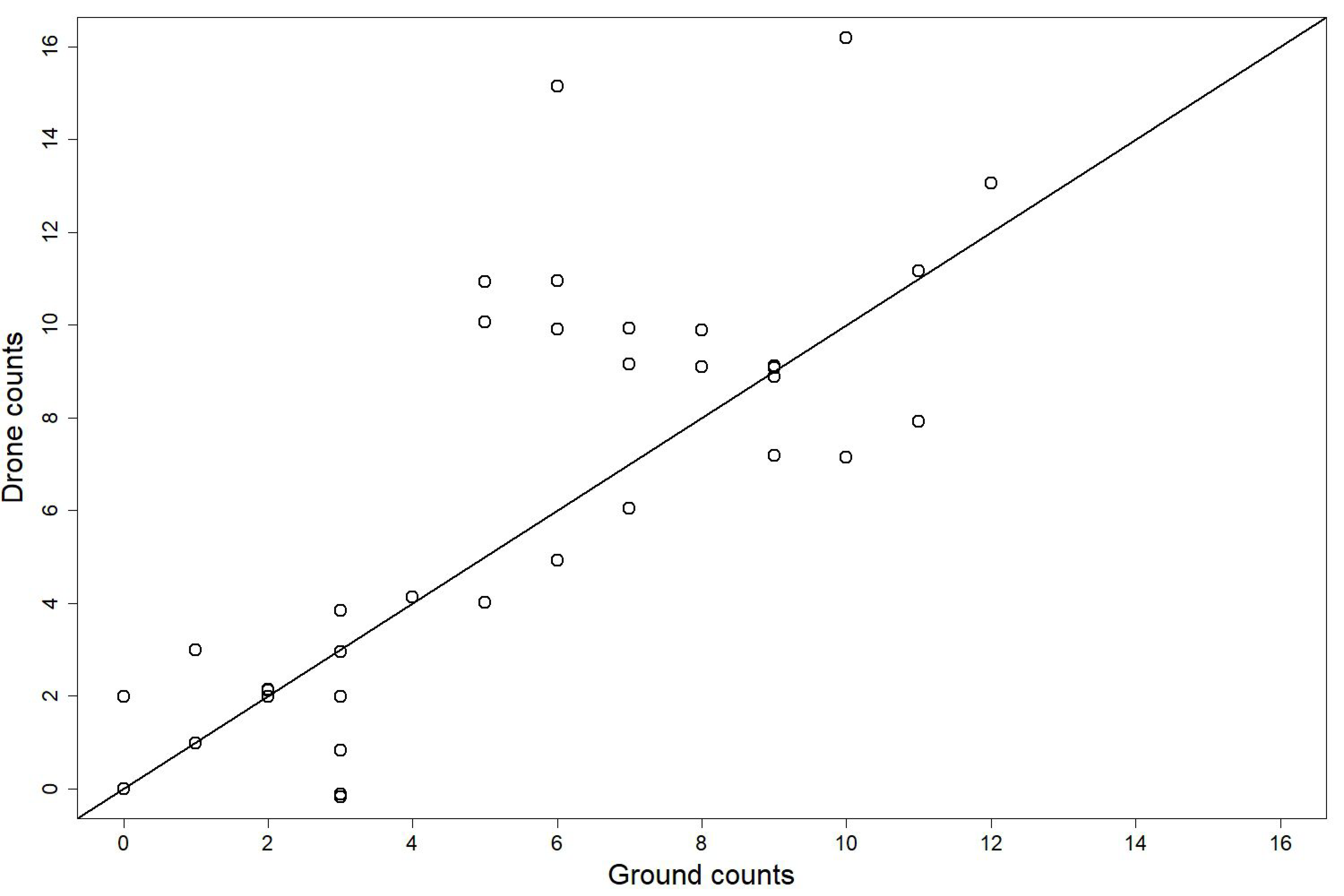
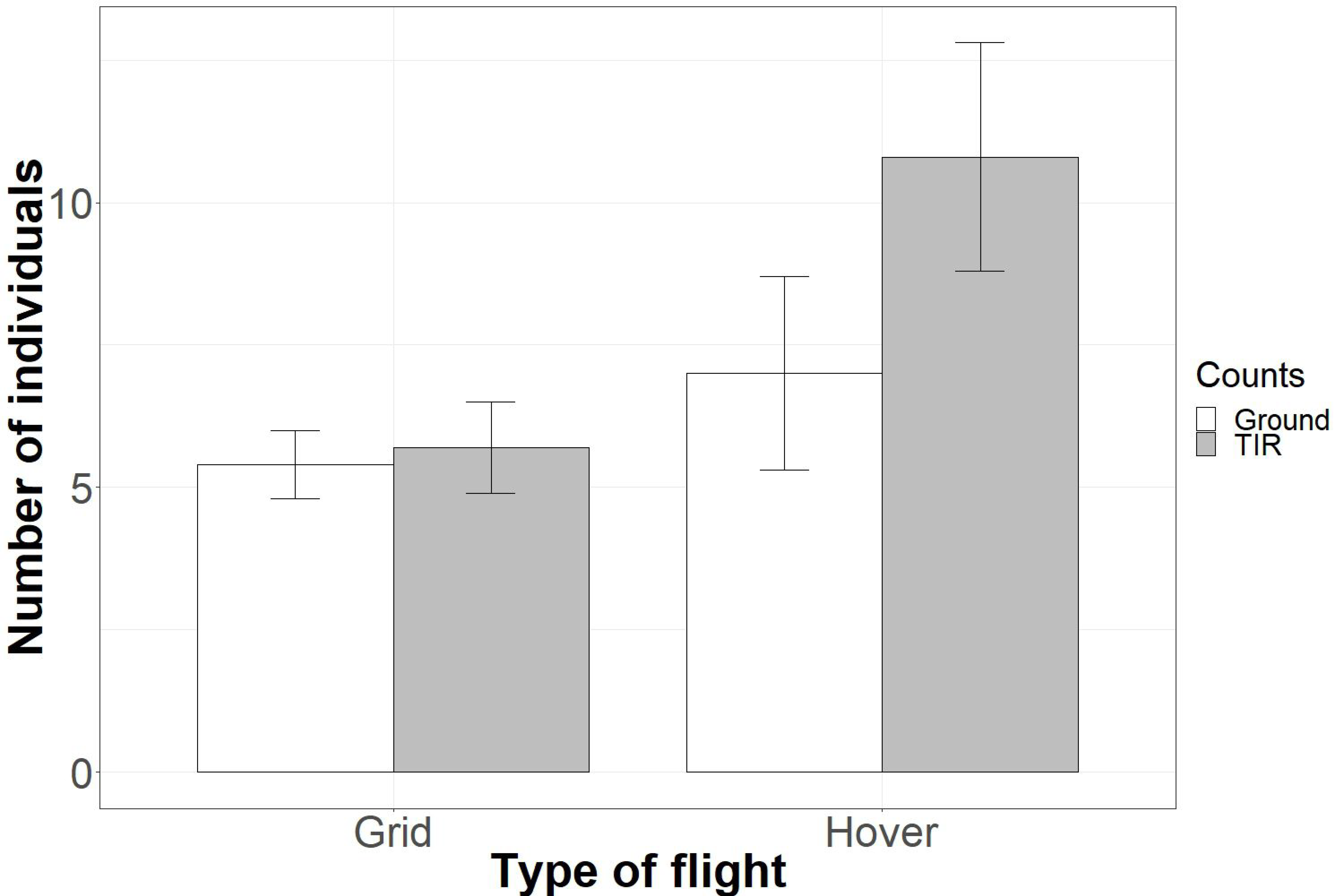
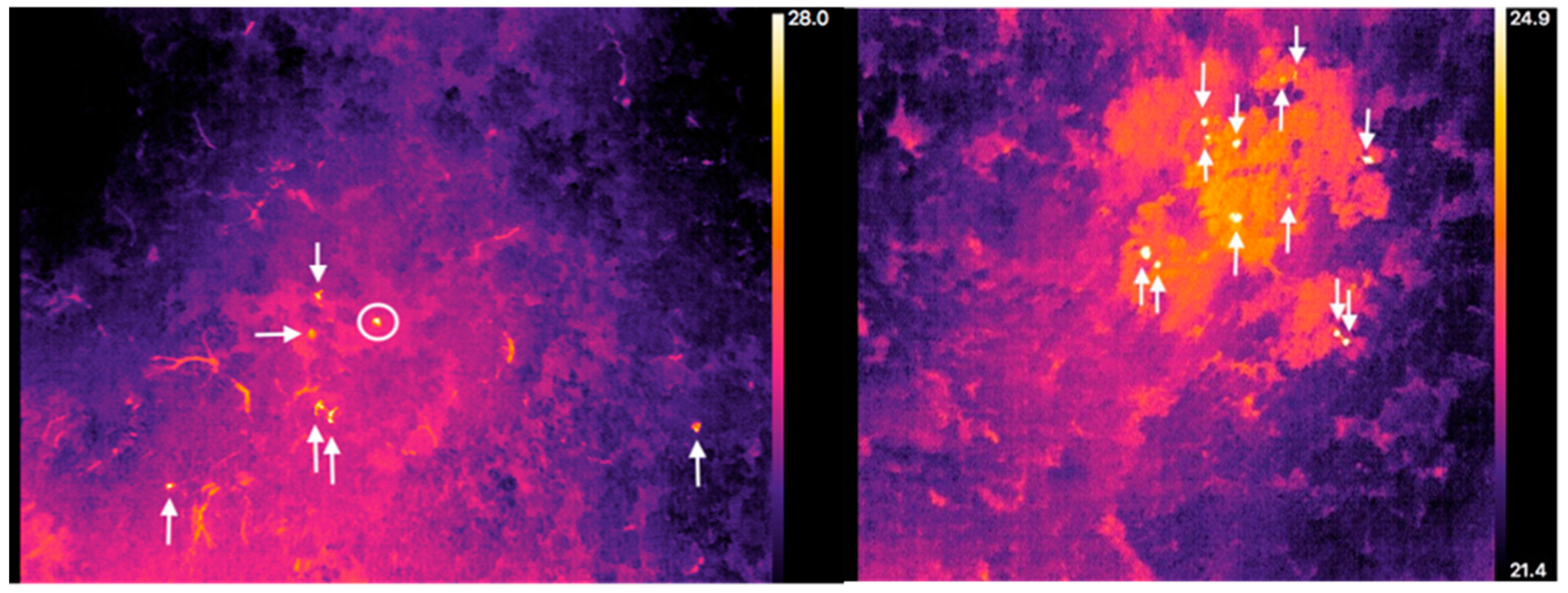
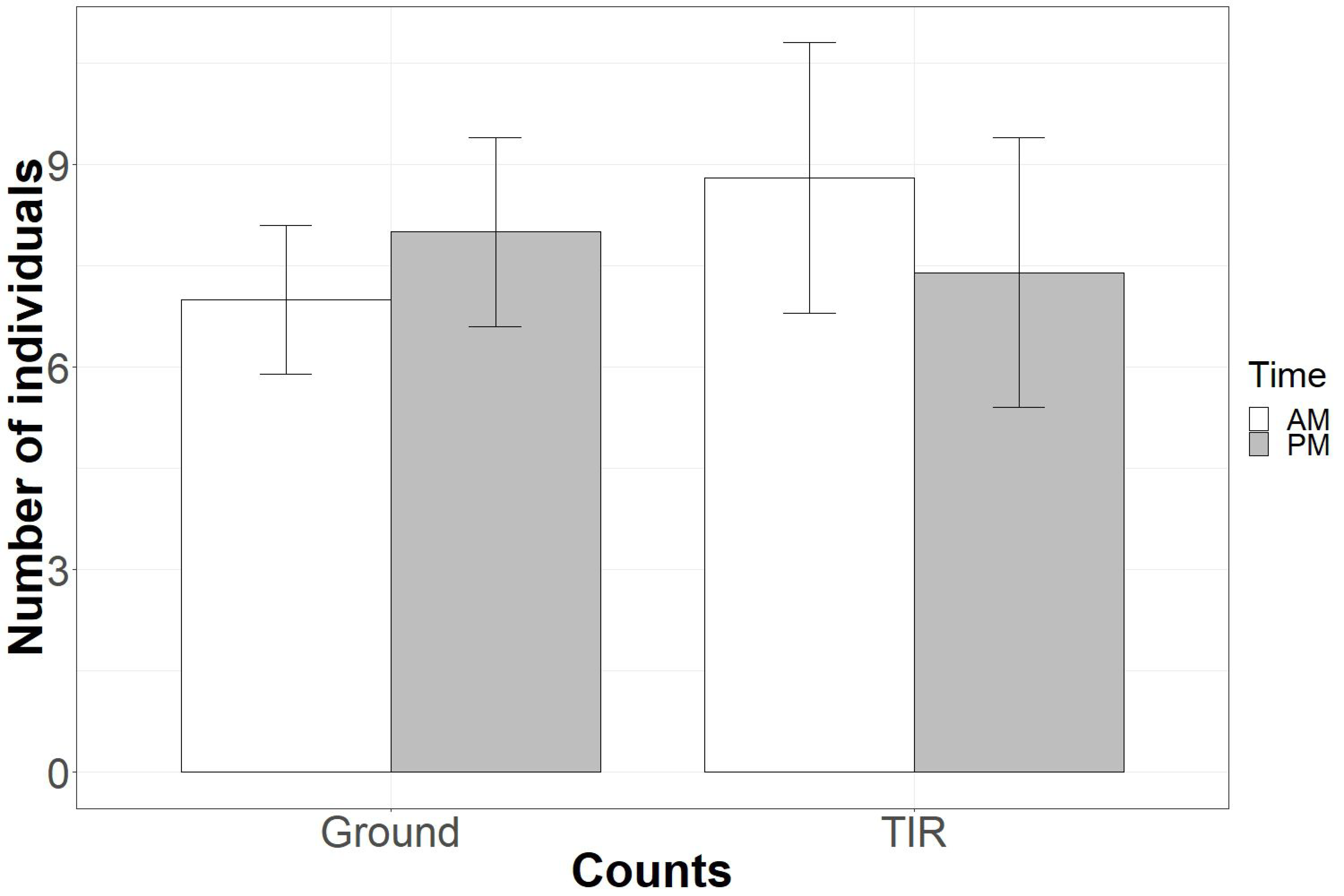
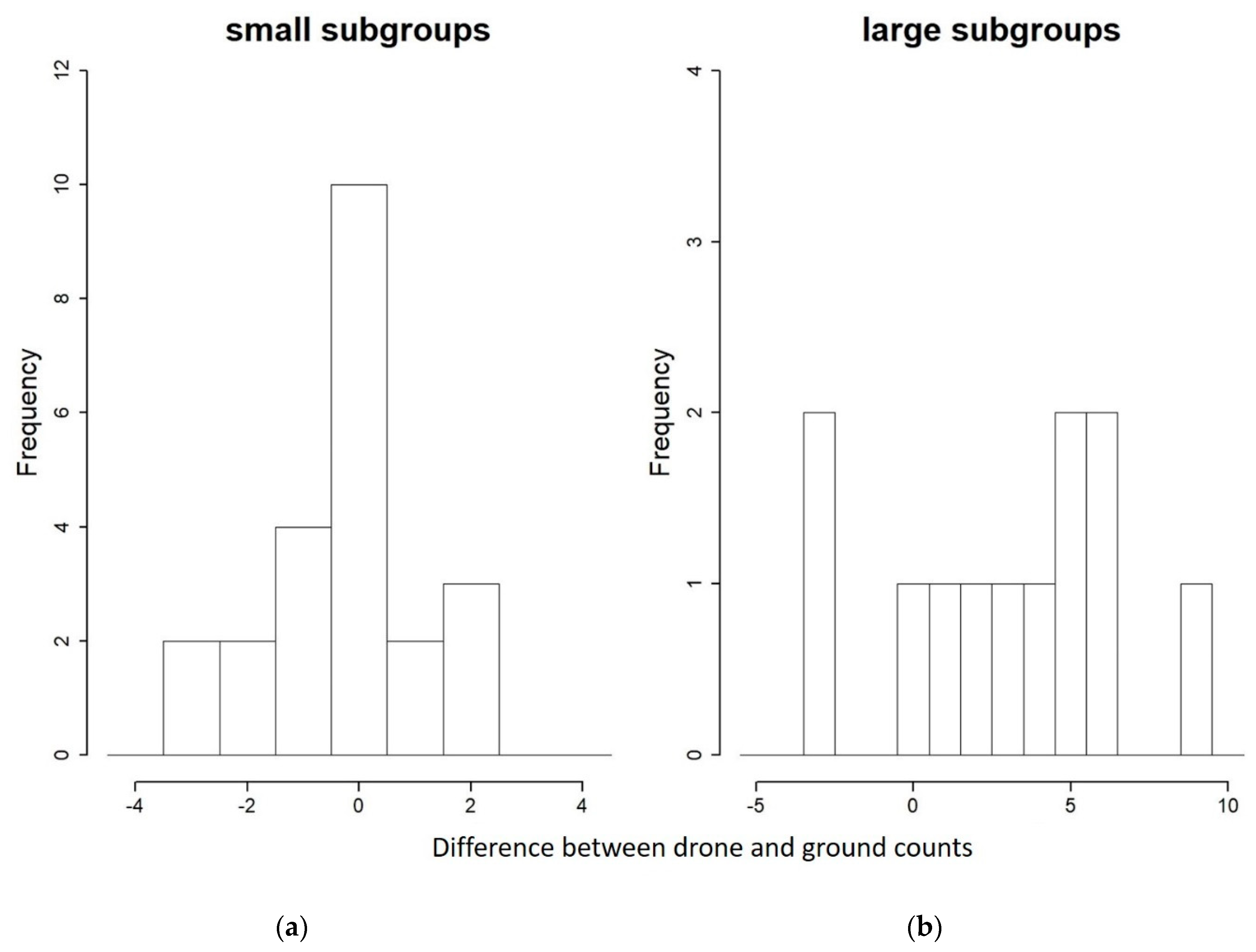
© 2019 by the authors. Licensee MDPI, Basel, Switzerland. This article is an open access article distributed under the terms and conditions of the Creative Commons Attribution (CC BY) license (http://creativecommons.org/licenses/by/4.0/).
Share and Cite
Spaan, D.; Burke, C.; McAree, O.; Aureli, F.; Rangel-Rivera, C.E.; Hutschenreiter, A.; Longmore, S.N.; McWhirter, P.R.; Wich, S.A. Thermal Infrared Imaging from Drones Offers a Major Advance for Spider Monkey Surveys. Drones 2019, 3, 34. https://doi.org/10.3390/drones3020034
Spaan D, Burke C, McAree O, Aureli F, Rangel-Rivera CE, Hutschenreiter A, Longmore SN, McWhirter PR, Wich SA. Thermal Infrared Imaging from Drones Offers a Major Advance for Spider Monkey Surveys. Drones. 2019; 3(2):34. https://doi.org/10.3390/drones3020034
Chicago/Turabian StyleSpaan, Denise, Claire Burke, Owen McAree, Filippo Aureli, Coral E. Rangel-Rivera, Anja Hutschenreiter, Steve N. Longmore, Paul R. McWhirter, and Serge A. Wich. 2019. "Thermal Infrared Imaging from Drones Offers a Major Advance for Spider Monkey Surveys" Drones 3, no. 2: 34. https://doi.org/10.3390/drones3020034
APA StyleSpaan, D., Burke, C., McAree, O., Aureli, F., Rangel-Rivera, C. E., Hutschenreiter, A., Longmore, S. N., McWhirter, P. R., & Wich, S. A. (2019). Thermal Infrared Imaging from Drones Offers a Major Advance for Spider Monkey Surveys. Drones, 3(2), 34. https://doi.org/10.3390/drones3020034






